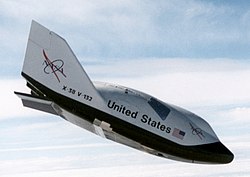

 Team ApproachSome 200 people were working on the project at Johnson, Dryden, and the Langley Research Center in Hampton, Va. This was the first time a prototype vehicle has been built-up in-house at JSC, rather than by a contractor; an approach that has many advantages. By building up the vehicles in-house, engineers had a better understanding of the problems contractors experience when they build vehicles for NASA. JSC's X-38 team will have a detailed set of requirements for the contractor to use to construct the CRVs for the ISS. This type of hands-on work was done by the National Advisory Committee on Aeronautics (NACA), NASA's predecessor, before the space age began. Dryden conducted model flights in 1995. The 1/6 scale-model of the CRV spacecraft using a parafoil parachute system was flown 13 times. The results showed that the vehicle had good flight control characteristics and also demonstrated good slideout characteristics
Team ApproachSome 200 people were working on the project at Johnson, Dryden, and the Langley Research Center in Hampton, Va. This was the first time a prototype vehicle has been built-up in-house at JSC, rather than by a contractor; an approach that has many advantages. By building up the vehicles in-house, engineers had a better understanding of the problems contractors experience when they build vehicles for NASA. JSC's X-38 team will have a detailed set of requirements for the contractor to use to construct the CRVs for the ISS. This type of hands-on work was done by the National Advisory Committee on Aeronautics (NACA), NASA's predecessor, before the space age began. Dryden conducted model flights in 1995. The 1/6 scale-model of the CRV spacecraft using a parafoil parachute system was flown 13 times. The results showed that the vehicle had good flight control characteristics and also demonstrated good slideout characteristics

| 歡迎光臨 鐵之狂傲 (https://gamez.com.tw/) |